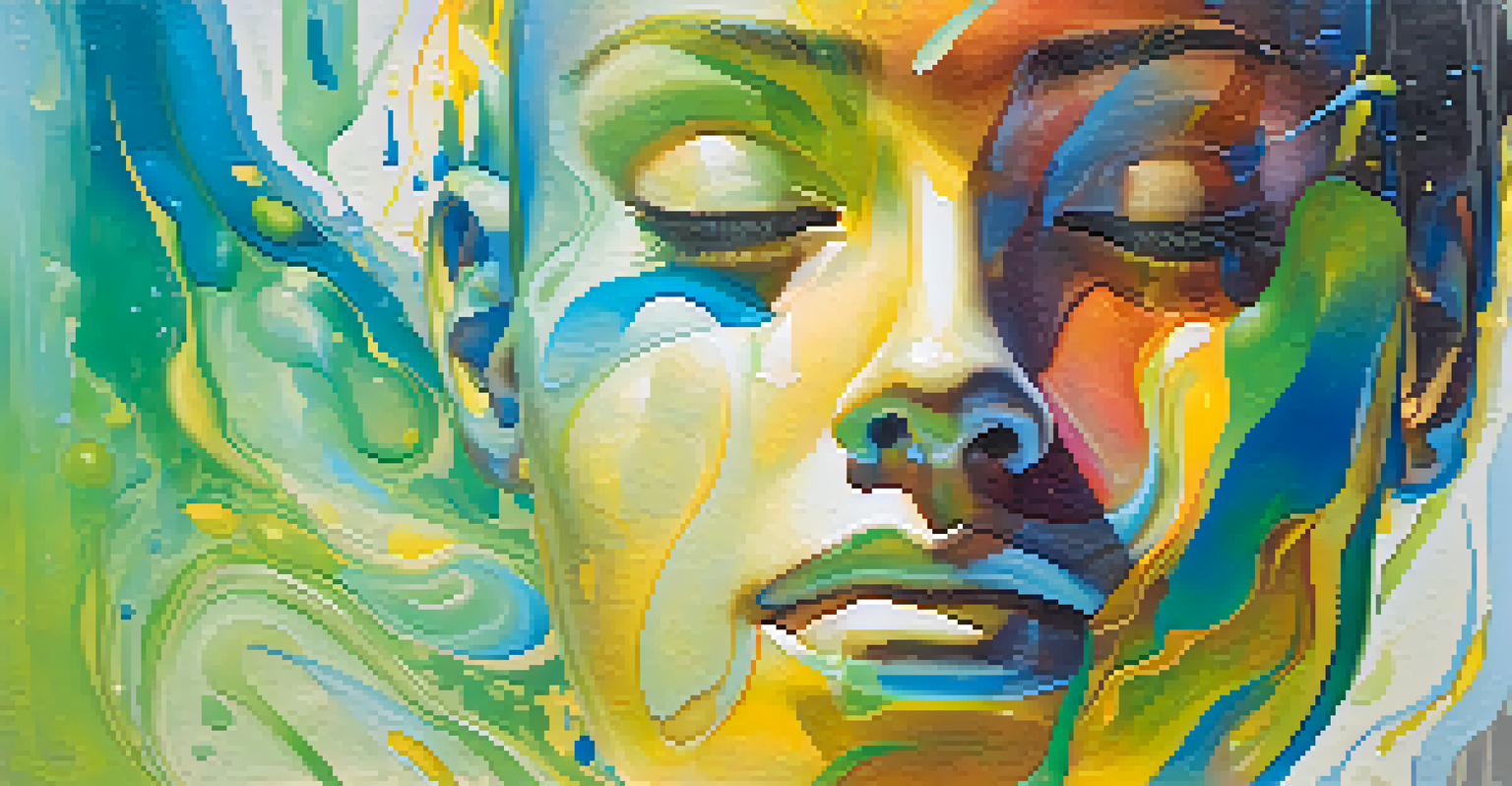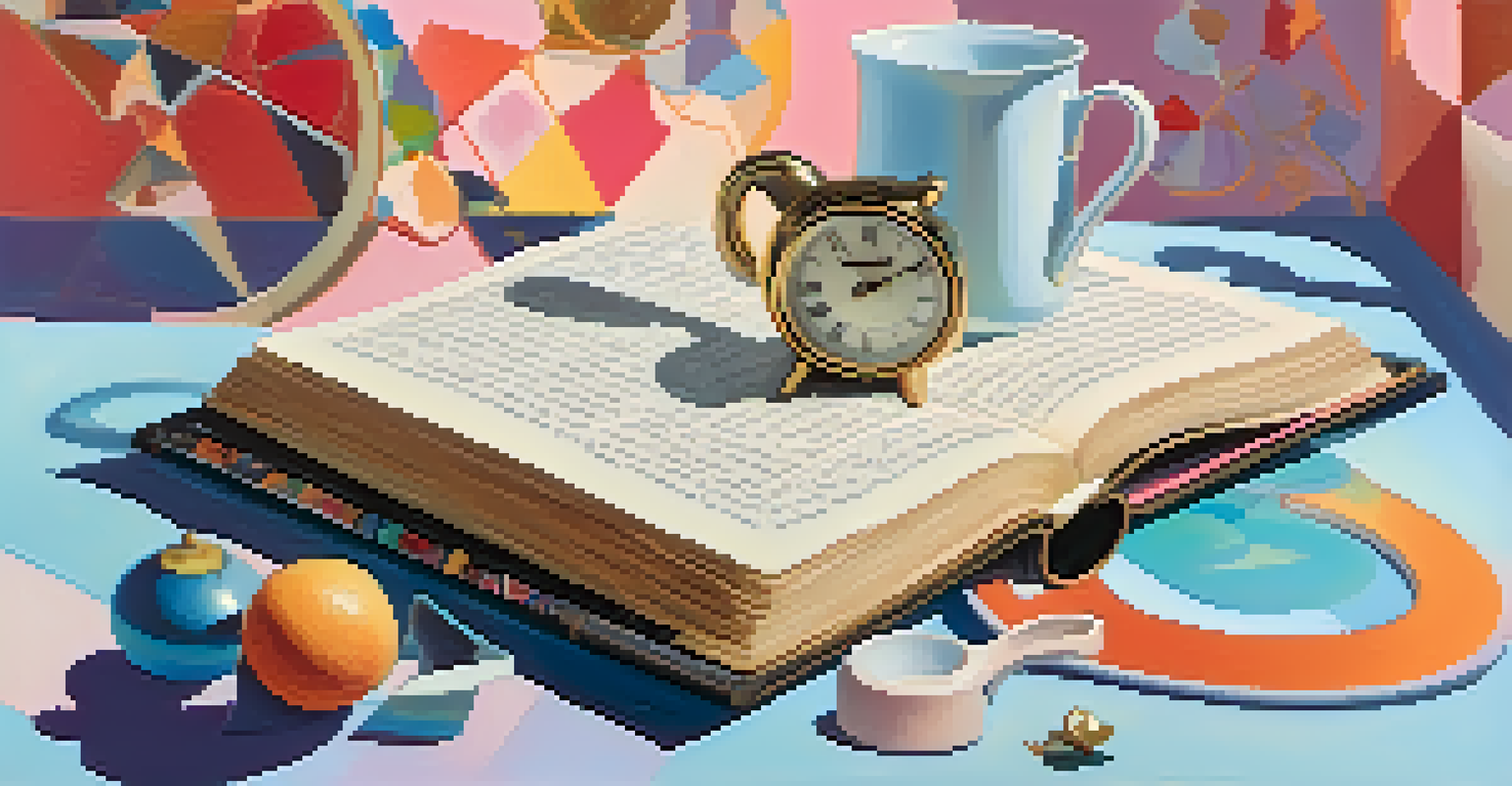The Impact of Surrealism on Abstract Painting Styles

Surrealism: A Brief Overview and Its Origins
Surrealism emerged in the early 20th century as a cultural movement that sought to challenge the conventional boundaries of art and reality. It was heavily influenced by the ideas of Sigmund Freud, particularly his theories on dreams and the unconscious mind. Artists like Salvador Dalí and André Breton sought to tap into the surreal aspects of human experience, creating works that often appeared bizarre or illogical.
The unconscious is the source of all our thoughts and feelings, and it is through the exploration of the unconscious that we can truly understand ourselves.
This movement encouraged artists to explore their subconscious, leading to imaginative imagery and unexpected juxtapositions. The playfulness and dreamlike quality of surrealism opened new avenues for creative expression. As artists began to experiment with form and color, the foundation was laid for the evolution of abstract painting styles.
Surrealism's ability to provoke thought and evoke emotion set the stage for the later development of abstract art. By breaking away from traditional representation, surrealists allowed for new interpretations of reality, a concept that would resonate deeply within the abstract art community.
Key Characteristics of Surrealist Art
At the heart of surrealism lies the exploration of dreams and the unconscious mind, often leading to unusual and fantastical imagery. Artists utilized techniques like automatic drawing and collage, which encouraged spontaneity and creativity without the constraints of rational thought. This departure from logical representation allowed for a more fluid approach to artistic expression.

Surrealist art frequently showcases bizarre combinations of everyday objects, creating a disorienting yet fascinating effect. This merging of the familiar with the unfamiliar invites viewers to engage in a deeper exploration of the meaning behind the artwork. Such techniques laid the groundwork for abstract artists to further push the boundaries of perception and reality.
Surrealism Challenges Artistic Norms
Surrealism emerged in the early 20th century, pushing the boundaries of art by exploring the subconscious and dreams.
As surrealism evolved, it began to incorporate elements of abstraction, blurring the lines between recognizable forms and pure abstraction. This interplay between the two styles would significantly influence the trajectory of modern art, leading to a greater acceptance of abstract techniques in subsequent movements.
The Transition from Surrealism to Abstract Art
As surrealism gained momentum, many artists began to experiment with abstraction as a natural progression of their work. This transition wasn't merely a rejection of surrealism; rather, it was an expansion of its principles. Artists like Wassily Kandinsky and Joan Miró, while rooted in surrealism, began to explore pure abstraction, moving away from recognizable imagery.
I paint objects as I think them, not as I see them.
This shift allowed for a more profound exploration of color, line, and form, emphasizing the emotional and psychological aspects of art. The use of abstraction in surrealist contexts encouraged artists to express their innermost thoughts and feelings without the constraints of representational forms. In this way, surrealism paved the way for the broader acceptance of abstract styles.
As the lines between surrealism and abstraction blurred, artists found new ways to evoke emotions and ideas. This melding of styles led to innovative movements such as Abstract Expressionism, which emphasized spontaneity and the artist's subconscious, echoing the core principles of surrealism.
Influential Abstract Artists Inspired by Surrealism
Several prominent abstract artists were deeply influenced by surrealism, incorporating its themes and techniques into their work. For instance, Jackson Pollock's drip paintings can be seen as an exploration of the subconscious, echoing the spontaneous techniques of surrealist artists. His emphasis on process and the act of painting itself aligns closely with the surrealist ethos of automatic creation.
Similarly, Mark Rothko's color field paintings evoke emotional responses that resonate with the dreamlike quality of surrealism. By focusing on the interplay of colors and shapes, Rothko invites viewers to experience a more profound connection with their emotions. This focus on feeling over form reflects the surrealist influence on abstract expression.
Evolution to Abstract Art
The transition from surrealism to abstract art allowed artists to express emotions through color and form, expanding the possibilities of artistic expression.
Artists like Arshile Gorky also blended surrealist motifs with abstract forms, creating works that transcend traditional representation. Gorky's paintings often evoke the subconscious, merging organic shapes with abstract elements, showcasing the seamless integration of surrealism into abstract art.
The Role of Dreams in Abstract Painting
Dreams play a significant role in both surrealism and abstract painting, offering a gateway to the subconscious. The imagery derived from dreams often serves as a source of inspiration for abstract artists, who reinterpret these visions in a non-representational manner. This connection highlights the shared goal of both movements: to explore the depths of human experience.
In abstract painting, the dreamlike quality can manifest through fluid shapes, unexpected color combinations, and rhythmic patterns. These elements invite viewers to engage with the artwork on a personal level, evoking their own emotions and interpretations. Just as surrealists sought to capture the essence of dreams, abstract artists utilize similar techniques to create immersive experiences.
The interplay between dreams and abstraction encourages a new way of seeing the world, where the viewer's imagination can roam freely. This shared foundation emphasizes the importance of the unconscious in artistic expression, bridging the gap between surrealism and abstract painting.
Cultural Context and the Evolution of Abstract Art
The cultural context of the early 20th century significantly influenced the evolution of abstract art. As societies grappled with the aftermath of World War I and the onset of modernity, artists sought new ways to express their experiences. Surrealism emerged as a response to these upheavals, pushing the boundaries of traditional art forms and paving the way for abstract movements.
The rise of industrialization and technological advancements also played a role in shaping abstract art. Artists began to explore new materials and techniques, allowing for greater experimentation and innovation. This shift encouraged the blending of surrealist and abstract elements, creating a dynamic landscape for artistic expression.
Lasting Impact on Contemporary Art
Surrealism's influence endures in modern abstract art, fostering creativity and imagination that shapes today's artistic landscape.
As artists responded to the changing world around them, the influence of surrealism on abstract painting became increasingly evident. The cultural landscape provided fertile ground for new ideas, resulting in a rich tapestry of artistic experimentation that continues to resonate today.
Conclusion: Surrealism's Lasting Legacy in Abstract Art
The impact of surrealism on abstract painting styles is both profound and enduring. By challenging traditional artistic norms and encouraging exploration of the subconscious, surrealism opened new avenues for abstract artists. The techniques and themes pioneered by surrealists continue to influence contemporary art, demonstrating the interconnectedness of these movements.
As we reflect on the legacy of surrealism, it's clear that its emphasis on creativity and imagination has shaped the way artists approach abstraction. This ongoing dialogue between the two styles fosters a vibrant and ever-evolving art scene. Artists today continue to draw inspiration from the surrealist movement, blending its principles with their unique perspectives.

In essence, the relationship between surrealism and abstract art serves as a testament to the power of artistic innovation and expression. As artists push the boundaries of creativity, the influence of surrealism will undoubtedly remain a vital part of the ongoing evolution of abstract painting.